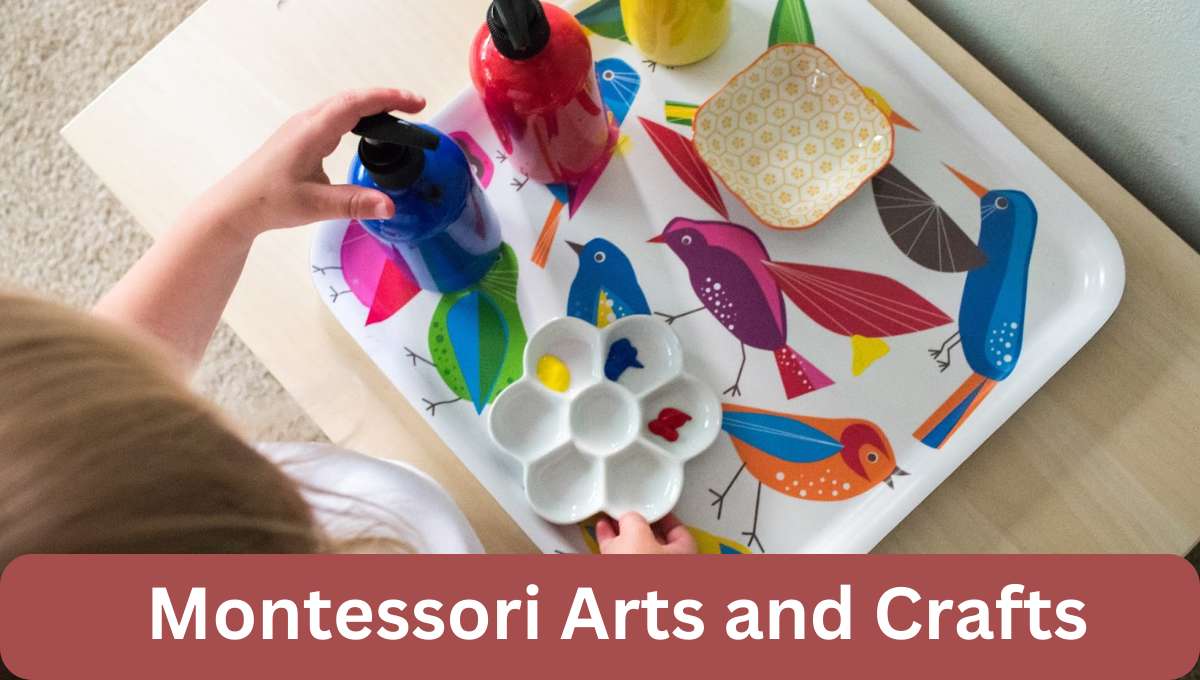Montessori Arts and Crafts
Montessori arts and crafts are designed to foster creativity, independence, and a sense of accomplishment in children. These activities follow the principles of the Montessori educational approach, which emphasizes hands-on learning, exploration, and the development of fine motor skills.
Goals of Montessori Arts and Crafts
Creativity
Montessori arts and crafts encourage children to express themselves creatively. By providing various materials and tools, children can explore their imagination and create unique artworks.
Fine Motor Skills
Engaging in arts and crafts activities helps develop fine motor skills, such as cutting, drawing, and painting. These skills are crucial for tasks like writing and self-care.
Concentration
The process of creating art requires focus and concentration. Montessori arts and crafts activities promote deep engagement, which enhances a child’s ability to concentrate on other tasks as well.
Problem-Solving
Art often involves solving creative problems, like figuring out how to assemble pieces or choosing colors. This nurtures a child’s problem-solving abilities and fosters critical thinking.
Self-Expression
Art serves as a medium for children to express their feelings, thoughts, and ideas without relying solely on words. It empowers them to communicate their emotions in a safe and nonverbal manner.
Independence
In Montessori arts and crafts, children are encouraged to make choices and work independently. This fosters a sense of autonomy and confidence in their abilities.
Benefits of Montessori Arts and Crafts:
Emotional Development
Engaging in art activities can be emotionally therapeutic. It allows children to process emotions and build a positive outlet for self-expression.
Sense of Accomplishment
Completing an art project gives children a sense of pride and accomplishment, boosting their self-esteem and confidence in their capabilities.
Cognitive Skills
Arts and crafts stimulate various cognitive abilities, including spatial awareness, pattern recognition, and understanding cause and effect.
Cultural Appreciation
Montessori arts and crafts often expose children to different cultural art forms and styles, promoting an appreciation for diversity and creativity across cultures.
Social Skills
Group art activities encourage cooperation, sharing, and communication with peers, fostering essential social skills.
Relaxation and Stress Relief
Art can be a calming and soothing activity, reducing stress and anxiety in children.
Long-Term Benefits
Engaging in arts and crafts at an early age can lead to a lifelong appreciation for art, culture, and creativity.
Montessori Approach to Arts and Crafts
Child-Led Exploration
In Montessori arts and crafts, the child is encouraged to take the lead. They have the freedom to choose the materials they want to work with and the projects they wish to create. This approach empowers children to follow their interests and engage in activities that resonate with them.
Process Over Product
Unlike traditional arts and crafts, where the final product is often the main focus, Montessori places greater importance on the process of creating. Children are encouraged to enjoy the journey of exploration, experimenting with different materials, and discovering their unique ways of expression.
Use of Natural and Hands-On Materials
Montessori arts and crafts prioritize the use of natural and eco-friendly materials. Children work with real objects rather than synthetic or overly structured toys. This connection to nature enhances sensory experiences and fosters a deeper understanding of the world.
Development of Fine Motor Skills
Montessori arts and crafts activities are designed to support the development of fine motor skills. These activities, like cutting, pasting, and drawing, help children refine their hand movements and coordination.
Sensory Exploration
Art activities in Montessori education often involve sensory elements. Children engage their senses of touch, sight, and sometimes smell and taste to experience the materials they work with. This sensory exploration enriches the learning experience.
Focus on Independence
Montessori believes in promoting independence in children. Art stations are set up in a way that allows children to access materials and tools on their own. They are encouraged to clean up after themselves and take responsibility for their workspace.
Open-Ended Creativity
Montessori arts and crafts activities are open-ended, meaning there’s no predetermined outcome or “right way” to create. Children are free to explore, experiment, and come up with their own ideas and solutions.
Integration with Other Subjects
Arts and crafts are not seen as isolated activities but are integrated with other subjects in the Montessori curriculum. For example, children might explore art techniques inspired by geography or history.
Observation and Individualized Approach
Montessori teachers observe each child’s interests, abilities, and progress. They tailor art activities to suit the unique needs of each child, ensuring a personalized and effective learning experience.
Montessori Arts and Crafts Activities by Age Group
Montessori arts and crafts activities are tailored to suit the developmental stages of children. Here are some age-appropriate Montessori arts and crafts activities:
Infants and Toddlers (0-3 years)
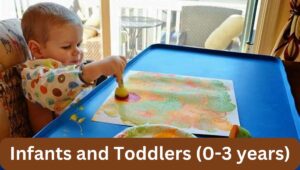
- Sensory Exploration
Provide safe and age-appropriate materials for infants to touch, feel, and explore, such as fabric swatches, textured balls, or soft brushes.
- Scribbling Tray
Offer toddlers a tray with large paper and chunky crayons for scribbling. This activity helps them practice hand-eye coordination and develop their grip.
Early Childhood (3-6 years)
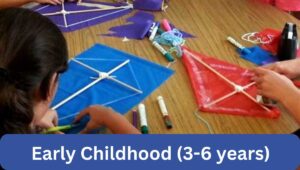
- Collage Making
Set out a variety of materials like colored paper, fabric, and natural objects. Children can use glue sticks to create collages, expressing their creativity.
- Nature Printmaking
Collect leaves, flowers, or other natural items and let children dip them in paint to make prints on paper. This activity combines art with exploration of the natural world.
- Playdough Creations
Provide homemade or non-toxic playdough for children to mold and shape, encouraging fine motor skills and imaginative play.
- Cutting Practice
Offer child-safe scissors and strips of paper for cutting practice, helping them develop their cutting skills.
Elementary (6-12 years)
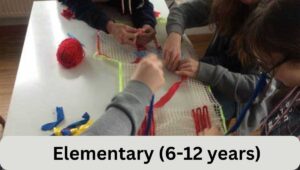
- Weaving
Introduce weaving with paper strips or simple looms. This activity enhances fine motor skills and introduces children to the concept of patterns and designs.
- Clay Sculpting
Provide clay and sculpting tools for children to create three-dimensional art pieces. Clay sculpting encourages focus, patience, and creativity.
- Nature Journaling
Encourage children to observe and sketch plants, animals, or natural scenes in a journal. This activity connects art with scientific exploration.
- Printmaking with Found Objects
Let children experiment with printmaking using found objects like leaves, cardboard, or bottle caps. This introduces them to basic printmaking techniques.
Montessori Arts and Crafts in the Digital Age
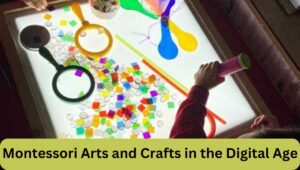
Montessori arts and crafts can adapt to incorporate technology while staying true to the core principles of the Montessori approach.
Digital Art Exploration
Introduce digital art tools like kid-friendly drawing apps or digital drawing tablets. Children can use their fingers or a stylus to create digital art, allowing them to explore different colors and brush styles.
Virtual Art Galleries
Take virtual field trips to art museums and galleries around the world. Children can explore famous artworks, learn about artists, and gain exposure to various art styles and cultural influences.
Art and Technology Integration
Combine technology with traditional art materials. For example, children can use a camera to take pictures of nature, and then incorporate those images into their physical art projects, like collages or nature-inspired drawings.
Animation and Storytelling
Introduce simple animation apps or software that allow children to create their own animated stories. This fosters creativity and storytelling skills while engaging with digital tools.
Online Art Classes
Offer online art classes or video tutorials led by skilled artists. This provides children with guided art lessons and allows them to learn new techniques from the comfort of their Montessori environment.
Digital Portfolios
Use digital platforms to create and share children’s art portfolios. This allows parents and educators to track the progress of their artistic development over time.
Art History Apps
Utilize interactive art history apps designed for children. These apps introduce famous artworks and artists in an engaging and age-appropriate way.
Digital Collaboration
Foster collaboration through digital art projects. Children can work together on shared documents or art platforms, encouraging teamwork and communication skills.
Virtual Art Exhibitions
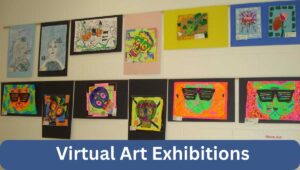
Organize virtual art exhibitions within the Montessori community. Children can showcase their digital and traditional artworks, sharing their creative expressions with peers and parents.
Digital Storybooks
Encourage children to create digital storybooks with illustrations and text. They can tell their stories and explore the combination of art and writing.
It’s essential to balance the use of digital tools with hands-on art experiences, ensuring that technology complements the Montessori arts and crafts environment rather than replacing it entirely. By embracing technology thoughtfully, Montessori education can leverage the digital age to enhance creativity, provide new learning opportunities, and connect children with a broader artistic world.
